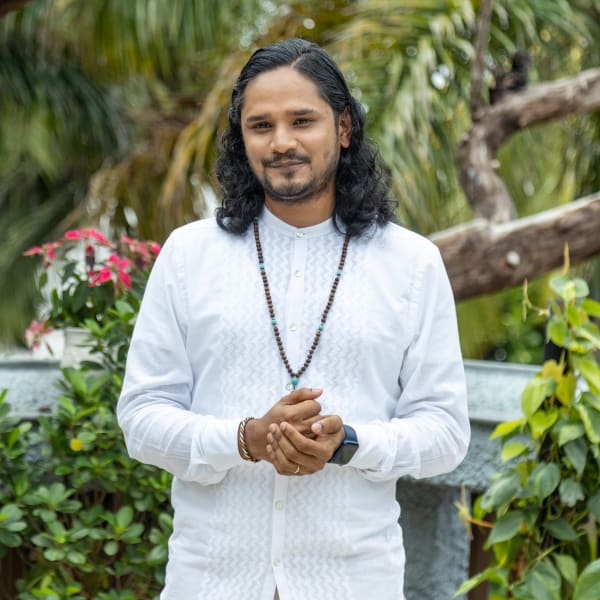What Are the 8 Limbs of Yoga?

The Yoga Sutras, written in the early centuries B.C., is widely considered as the authoritative text on yoga theory and practice. The seminal book of classic yoga theory includes historic words of wisdom and guidance, and is written by the Indian sage Patanjali, who is considered the father of yoga.
Patanjali’s Yoga Sutras details the eightfold path to enlightenment, also known as the eight limbs (or branches) of yoga. When practiced, these limbs function as steps to controlling the mind in pursuit of liberation. Meditation teacher Tyagi Shurjo teaches the eightfold path in his course Yoga's 8-Step Path to Awakening so that students may apply these eight steps to find freedom in their own lives. The eight limbs of yoga are guidelines for leading a life of meaning, purpose, and authenticity.
Try this course, Yoga's 8-Step Path to Awakening, taught by meditation teacher Tyagi Shurjo.
First Limb of Yoga: The Yamas
Yamas, or universal laws of being, are often translated as “restraint” or “moral disciplines.” There are five yamas to follow: ahimsa (non-harming), satya (truthfulness), asteya (non-stealing), aparigraha (non-grasping), and brahmacharya (celibacy). These ethical practices are meant to be lived daily. “Yamas are ultimately about control,” says Shurjo. “Otherwise, our energy would always go in the direction of making things more convenient for ourselves.”
Second Limb of Yoga: The Niyamas
The second limb of Patanjali’s eightfold path, the niyamas are recommendations for healthy living that relate to a practitioner’s personal behavior. Often translated as positive duties or observances, niyamas refer to “where you should be putting your energy,” says Shurjo. The five niyamas are saucha (cleanliness), santosha (contentment), tapas (self-discipline), svadhyaya (self-study), and ishvara pranidhana (devotion). Niyamas work in harmony with the yamas — practicing niyamas provides a strong foundation for the niyamas to be cultivated. “Both yamas and niyamas are outward observances of how to interact with the world,” says Shurjo.
Third Limb of Yoga: Asana
Asana in yoga means posture. It’s the physical practice that most people think of today when they hear yoga. But asana is only one of yoga’s eight limbs as described by Patanjali in the Yoga Sutras. Therefore, asana is a way to practice yoga, but it’s not yoga itself. Practicing asana helps prepare the physical body for meditation. “Asanas help us take that energy that yamas and niyamas have harmonized, and focus them into our meditation,” says Shurjo.
Fourth Limb of Yoga: Pranayama
Pranayama (breathwork) fosters a connection between our breath, mind, and emotions. According to Patanjali, pranayama helps us purify the mind and regain focus. Practicing pranayama means performing breathing exercises to increase the flow of prana (life force energy) says Patanjali. “The flow of energy from prana is magnetic. Through pranayama, we are communicating with the world constantly,” says Shurjo.
Fifth Limb of Yoga: Pratyahara
Each of the other seven limbs of yoga contain some aspects of pratyahara practice. Translated, it means control, or mastery, over external influences — but we most commonly hear it to mean “withdrawal of the senses.” Think of it like a turtle withdrawing into its shell — in this case, the shell is the mind, and the withdrawn limbs are the senses. We practice pratyahara to free the mind of distractions caused by sensory activity, such as nagging sounds, unpleasant smells, or physical sensations like an itch. This quieting of the mind from our own senses helps us condition our mind to let go of what’s pestering us, building the foundation for the higher practices of yoga and meditation. “Pratyahara teaches us to withdraw and not waste our energy,” says Shurjo. When we cultivate pratyahara, we develop the ability to interiorize our energy or prana and withdraw from our senses and the outer world.
Sixth Limb of Yoga: Dharana
“After we withdrawal our energy, where are we going to send it?” asks Shurjo. During meditation, dharana is the complete absorption into concentration. During dharana we fixate the mind on a single object — either external, like an om symbol or a deity, or internal, like the third eye. “Our mind always keeps us on the past or future,” says Shurjo. This focus is about being singularly present in this moment.”
Seventh Limb of Yoga: Dhyana
All preceding limbs of yoga prepare us for dhyana, where we move into a practice of true meditation. Dhyana is often translated as "contemplation," "reflection," and "profound, abstract meditation." To practice dhyana involves intense concentration and meditation on a single object or focus with the intent of learning the truth about it.
“In this stage of the eightfold path, we want to become so absorbed that there is nothing else,” says Shurjo. Dhyana is what most meditators practice towards – the inner calm and stillness of quiet-minded and deep meditation. Through the practice of meditative absorption, we are able to move into the final limb of yoga, samadhi — enlightenment.
Eighth Limb of Yoga: Samadhi
The eighth and final limb of yoga is thought to be the highest state of consciousness achievable through meditation where object and subject become one and there are no boundaries between time and space. When individual consciousness merges with universal consciousness, you have achieved samadhi, says Shurjo. To experience samadhi, a yogi must practice all eight limbs of yoga, over and over again. When we continue with our practice and push it further, our sense of consciousness expands.
Key Takeaways:
- Patanjali’s Yoga Sutras details the eightfold path to enlightenment, also known as the eight limbs (or branches) of yoga.
- The eight limbs of yoga are guidelines for leading a life of meaning, purpose, and authenticity.







